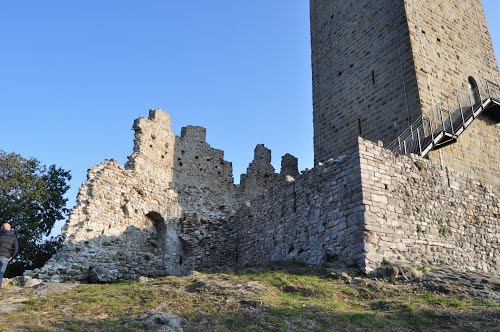 |
| Byzantine Castello Baradello near the Alps |
Defending Byzantine Italy
- With the Frankish Kingdom close by, the Castello Baradello was one of many border fortifications that protected the frontier of the Roman Empire.
The Gothic Wars
In an attempt to reconquer the Western Roman Empire the Emperor Justinian invaded the Ostrogothic Kingdom of Italy in 535 AD.
In a vicious war lasting 19 years much of Italy was largely destroyed.
Some historians claim Justinian's conquest was a Pyrrhic victory that drained national resources. To that I would disagree. Though the invading Germanic Lombard tribes took large sections of Italy, huge portions remained under the control of the Eastern Empire for another 500 years.
With the end of the war in 554 Justinian began projects to rebuild Italy and repair or begin new military fortifications to defend the frontiers. Castello Baradello was one of those fortresses.
The Castello Baradello
The castle is a military fortification located on a 430 m (1,410 ft) high hill next to the city of Como, northern Italy. The castle has breathtaking views: from here, you can admire the city, the lake, the Po Valley, the peaks of the Alps and even the Apennines. The name itself, in its origin, means "high place".
The castle occupies the ancient site of Comum Oppidum, the original settlement of Como, dating from the 1st millennium BC. Later it was one of the last Byzantine strongholds in the area, surrendering to the Lombards in 588.
 |
| Castello Baradello near Como, Italy. |
The best-preserved structure in the whole complex is undoubtedly the Romanesque square tower, whose base measures approximately 8 meters on each side. Its overall height is about 28 meters. The lower part is about 19 and a half meters high, it rests its foundation on the rock and it was formerly adorned with Guelph battlements; the upper part, which is also the most recent one, it’s 8 meters high and it was formerly crenellated with Ghibelline battlements. The battlements is now gone.
The first order of walls surrounding the tower dates back to the Byzantine era, to the Sixth or Seventh century, thus representing the castle’s oldest structure. We find mention of them already in the early Seventh century, thanks to the historian George of Cyprus, who described a complex defensive system called “Byzantine Limes”. Another wall, a newer one, surrounds these walls; it is contemporary with the raising of the tower and the inner walls. It is accessible through a charming and fascinating pointed doorway.
Nothing is the left of the other structures being part of the castle, except for their foundations; however, it was possible to reconstruct the whole layout. There was the chapel of St. Nicholas, which according to studies and researches is contemporary with the primitive walls; therefore, it dates back to the Sixth century. According to tradition, Napo Torriani was buried here, but no bones were ever found.
According to historical records, this castle served as a place of refuge for the population during the wars between Como and Milan. Thanks to subsequent agreements, Emperor Frederick Barbarossa rebuilt the city walls and Castel Baradello in 1158, strengthening it with the new tower. The following year the castle was home to the emperor and his wife, Beatrice of Burgundy, and on that occasion, the victory over Milan was celebrated with a Palio, that is still relived annually.
Castel Baradello was demolished in 1527 by the Spanish captain Cesareo don Pedro Arias on the orders of the governor of Milan, Antonio de Leyva, to prevent it from being conquered by French troops. Only the tower remained standing.
 |
| The most preserved element is a square tower, measuring 8.20 m × 8.35 m (26.9 ft × 27.4 ft) at the base, and standing at 27.50 m (90.2 ft). It once had Guelph-type merlons. The walls are of Byzantine origin (6th-7th century); these were later heightened and provided with Guelph merlons, while another external line of walls was added. . Also from the 6th century are the Chapel of St. Nicholas and quadrangular tower (4.40 m × 4.15 m (14.4 ft × 13.6 ft) at the base), which was used as the castellan's residence. Napoleone della Torre was buried in the Chapel of St. Nicholas. |
(wevillas.com) (Gothic War) (Baradello)




No comments:
Post a Comment